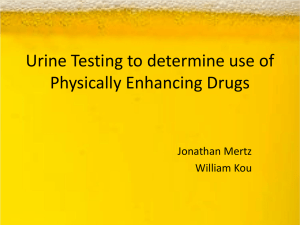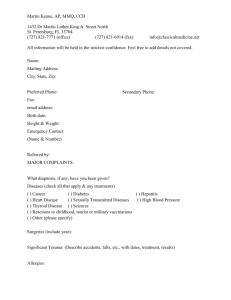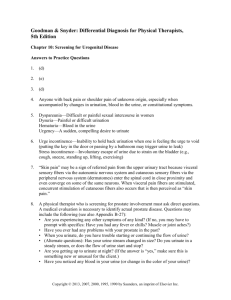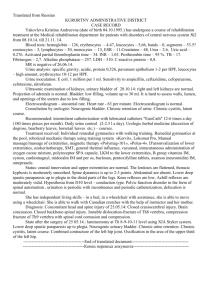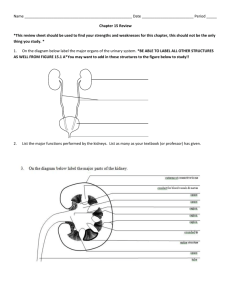Ketone Urinalysis - Utahhealthsciences.net
advertisement
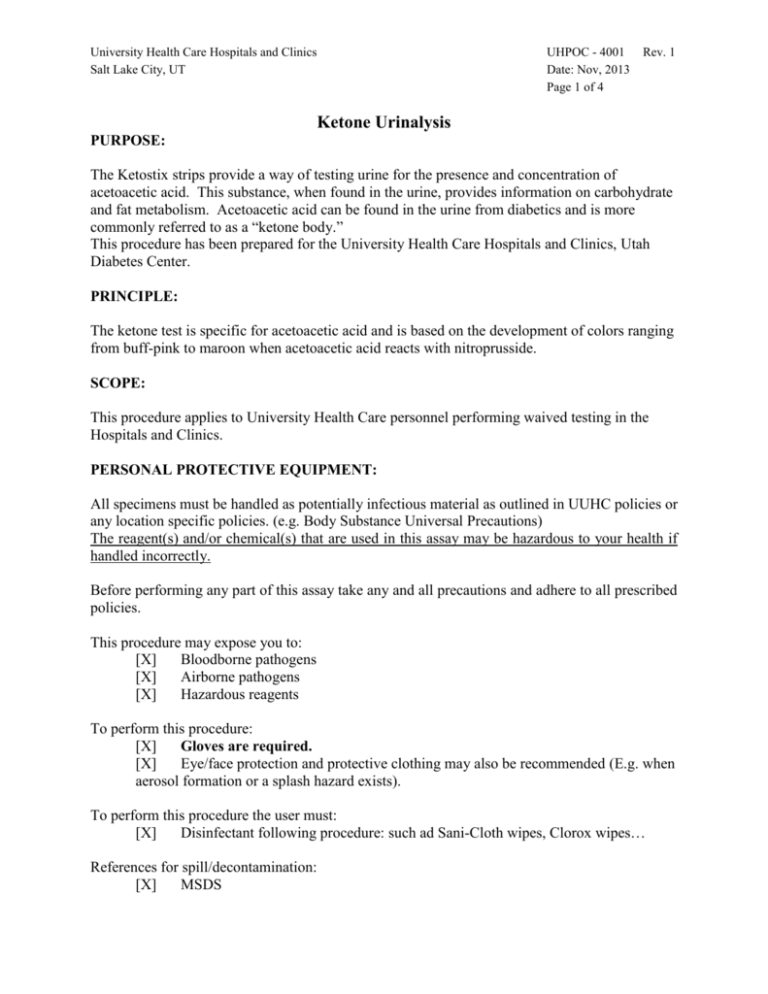
University Health Care Hospitals and Clinics Salt Lake City, UT UHPOC - 4001 Date: Nov, 2013 Page 1 of 4 Rev. 1 Ketone Urinalysis PURPOSE: The Ketostix strips provide a way of testing urine for the presence and concentration of acetoacetic acid. This substance, when found in the urine, provides information on carbohydrate and fat metabolism. Acetoacetic acid can be found in the urine from diabetics and is more commonly referred to as a “ketone body.” This procedure has been prepared for the University Health Care Hospitals and Clinics, Utah Diabetes Center. PRINCIPLE: The ketone test is specific for acetoacetic acid and is based on the development of colors ranging from buff-pink to maroon when acetoacetic acid reacts with nitroprusside. SCOPE: This procedure applies to University Health Care personnel performing waived testing in the Hospitals and Clinics. PERSONAL PROTECTIVE EQUIPMENT: All specimens must be handled as potentially infectious material as outlined in UUHC policies or any location specific policies. (e.g. Body Substance Universal Precautions) The reagent(s) and/or chemical(s) that are used in this assay may be hazardous to your health if handled incorrectly. Before performing any part of this assay take any and all precautions and adhere to all prescribed policies. This procedure may expose you to: [X] Bloodborne pathogens [X] Airborne pathogens [X] Hazardous reagents To perform this procedure: [X] Gloves are required. [X] Eye/face protection and protective clothing may also be recommended (E.g. when aerosol formation or a splash hazard exists). To perform this procedure the user must: [X] Disinfectant following procedure: such ad Sani-Cloth wipes, Clorox wipes… References for spill/decontamination: [X] MSDS University Health Care Hospitals and Clinics Salt Lake City, UT UHPOC - 4001 Date: Nov, 2013 Page 2 of 4 Rev. 1 REAGENTS AND EQUIPMENT: NOTE: Label any reagents/controls with the open date and expiration date. Do not use any reagents beyond their expiration date. Dipsticks: Bayer Ketostix: Store at Room temperature (15-30 C), out of direct sunlight with the cap tightly closed. Unopened stability: until expiration date on the container. Once opened: Discard strips 6 months after opening External Controls: BioRad qUAntify controls: Store at refrigerator temperature (2-8 C). Unopened stability: until expiration date on the box. Once opened: discard 31 days after opening Timing device Plastic transfer pipettes (optional) SPECIMEN COLLECTION: Collect: Freshly voided urine in a sterile container. The urine container should be free of additives. Collect enough urine to ensure that all the reagent strip pads will be immersed in urine. Unacceptable: Visibly bloody or unusually colored. Stability: Ambient: 1hour, Refrigerated: 24 hours Note: Testing should be done as soon as possible. If testing cannot be done within an hour after voiding, o Refrigerate the specimen; when ready to test allow the sample to reach room temperature and mix well before testing. OR o Transport the urine specimen to the Clinical Laboratory in the approved urine transport tube. Light yellow Vacutainer laboratory tube; No additive. 10mL aliquot (Min: 6ml) CAUTION: ACD tubes resemble urine collection tubes. QUALITY CONTROL: Each new vial of dipsticks must be tested with both levels of external control before using the dipsticks for patient testing. Use the reference control sheets included with the controls to determine if constituents are within the recommended range. After opening, each vial of dipsticks must be retested with both levels of QC every 31 days. Test Quality Control solutions the same way as patient samples (see Procedure below). The results of the controls should be recorded on the appropriate QC log or location specific report form. University Health Care Hospitals and Clinics Salt Lake City, UT UHPOC - 4001 Date: Nov, 2013 Page 3 of 4 Rev. 1 QC Troubleshooting: If any results are out of range, remove another dipstick from the vial and repeat the same control solution. If results are still out, open a new set of controls, and retest with the new reagent strips. If results are still out of range, open a new bottle of reagent strips and retest. If results still fall outside of range, DO NOT report outpatient results. Notify the Point of Care Coordinator. PROCEDURE: Note: Wear gloves when handling urine and control solutions. 1. Obtain a urine sample from the patient and label the container with the patient’s name and unique identification number. 2. Mix sample well. 3. Record color and appearance of urine as: Color: colorless, straw, yellow, brown, orange, red, green/blue or black. Appearance: clear, hazy, turbid or cloudy. Note: Unusually dark colored urines (bilirubin or hemolysis), or substances that cause abnormal urine color (pyridium, or other drugs containing dyes) may affect the readability and interpretation of the reagent pad. If colors cannot be read with certainty, report them as “Unable to interpret due to color interference” 4. Remove a dipstick from the container and replace cap. 5. Completely immerse reagent area of the strip in urine. 6. Blot the urine dipstick (on one edge) on a paper towel to remove any excess urine and to prevent “run-over”. 7. Using the timing device, read and record the results at exactly 15 seconds. 8. Compare the results of the immersed dipstick to the color chart located on the side of the dipstick container and record the appropriate color changes. Note: Read the pads in an area with good lighting. Hold the strip close enough to color blocks and match carefully. Avoid laying the strip directly on the color chart, as this will result in the urine soiling the chart. The dipstick container can be cleaned with an alcohol wipe. REPORTING AND INTERPRETING RESULTS: Record the patient’s name, medical record number or DOB, testing location, date, time, patient’s result and performing individual’s initials on the appropriate MediTape or Clinic Specific report form. REFERENCE INTERVALS: Ketone – negative Record Retention: All Point of Care (POC) testing results and quality control data MUST be available for review for 2 years. University Health Care Hospitals and Clinics Salt Lake City, UT UHPOC - 4001 Date: Nov, 2013 Page 4 of 4 Rev. 1 PROCEDURAL NOTES: 1. Do not store dipsticks in direct sunlight. 2. Do not use product after the expiration date. 3. Strips need to be stored in their original container with the cap securely closed and at room temperature (15-30° C). 4. Do not remove the desiccant from the bottle. 5. Do not remove the strip from the bottle until immediately before use. 6. Do not touch the test pads. 7. Discoloration or darkening of the test pads may indicate deterioration. 8. Use fresh urine to obtain optimal results. 9. If colors cannot be read with certainty, report them as “Unable to interpret due to color interference” 10. Do not transfer strips to another bottle. 11. The ketone reagent area is most accurate when testing urines of specific gravity between 1.010 and 1.020. LIMITATIONS: Note: Definitive diagnostic or therapeutic decisions should not be based on any single result or method. Ketone: False trace results may occur with highly pigmented urine specimens. Some high specific gravity-low pH urines may give reactions up to and including Trace. Clinical judgment is needed to determine the significance of “trace” results, which may occur during physiological stress conditions such as fasting, pregnancy and frequent strenuous exercise. Substances that cause abnormal urine color, such as drugs containing azo dyes (e.g., Pyridium, Azo Gantrisin, Azo Gantanol), nitrofurantoin (Macrodantin, Furadantin), and riboflavin, may affect the readability of the ketone reagent area on the Ketostix reagent strips. The color development on the reagent pad may be masked, or a color reaction may be produced on the pad that could be interpreted as a false positive. False positive results (Trace or less) may occur with highly pigmented urine specimens or those containing large amounts of levodopa metabolites. Compounds such as mesna (2mercaptoethane sulfonic acid) that contain sulfhydryl groups may cause false positive results or an atypical color reaction. BACKUP TESTING: Clinical Laboratory UADIPSTICK (acronym for ordering) REFERENCES: Bayer Ketostix reagent strips product insert Biorad qUAntify liquid urine control material product insert



